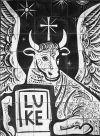
THE GOSPEL OF LUKE
Luke and Mark
I have listed out the comparison of Luke with Mark, that is using Mark's sequence of events as our guide. I have also added Mk 6,1-6 at the end.
You may find it helpful to clarify the details by doing the opposite and compare Mark following Luke's sequence.
| Jesus returns to Galilee | Mk 1,14-15 | Lk 4,14-15 | Call of disciples | Mk 1,16-20 | Lk 5,1-11 |
| Capernaum synagogue | Mk 1,21-28 | Lk 4,31-37 |
| Peter's Mother in Law | Mk 1,29-31 | Lk 4,38-39 |
| Summary | Mk 1,32-39 | Lk 4,40-44 |
| Healing of a leper | Mk 1,40-45 | Lk 5,12-16 |
| Five healings | Mk 2,1-3,6 | Lk 5,17-6,11 |
| Summary | Mk 3,7-12 | |
| Naming the Twelve | Mk 3,13-19 | Lk 6,12-16 |
| Sermon at Nazareth | Mk 6,1-6 | Lk 4,16-30 |
In summary, the table shows us how Luke follows Mark quite closely for much of this opening part of the ministry up to 6,16, Mk 3,19. This is especially true from Mk 1,40 through to Mk 3,6. Luke however postpones the call of the disciples (5,1-11) until after Mk 1,39.
Instead of the immediate call of disciples as in Mark, Luke has brought forward the sermon at Nazareth and placed it as we have seen immediately after Jesus' return to Galilee. He has also greatly expanded Mark's version of the sermon, Mk 6,1-6.
Luke's omission is the summary provided in Mk 3,7-12. This mentions the great crowds coming from all over the place. Luke in his Gospel keeps Jesus' ministry with the Jews. He has a second volume to describe the mission of the early Church.
Overview Lk 5,12-6,11
Because Luke is following Mark so closely at this point, it is easy to spot from our table the series of five conflicts between Jesus and the Pharisees preceeded by the healing of a leper. In Mark, the healing of the leper comes at the end of chapter 1 and the five follow as a group, Mk 2,1-3,6. It is then easy to interpret them as similar to Mark which is done by many commentators. Yet Luke is not Mark and as we look more closely we find how his editing brings out a different message. That is the consequence of Luke placing the call of the disciples, 5,1-11, where he did, before the healing of the leper, 5,12-16. Luke has placed the call of the disciples with the result that the healing of the leper becomes linked more closely with what follows.
Here we can note that Mark has a clear new beginning in Mk 2,1 after the healing of the leper with Jesus going back again to Capernaum. Luke however begins both 5,12 (the leper) and 5,17 (the paralytic) with the phrase "it happened that". That is a much weaker break than we find in Mark.
The consequence is that Luke has made 5,12-6,11 a unit. Luke's insertion of the calling of the disciples in 5,1-11 makes the healing of the leper in 5,12-16 part of the sequence which follows instead of being rather on its own as in Mark. Luke has been given the healing of the leper a clearer purpose by linking it with the second healing, that of the paralytic. However we will see how he has kept the cycle to five incidents as we now look at his editing of the centre of the sequence, 5,27-39.
A Call and a Dispute: 5,27-39
Both Mark (Mk 2,18) and Matthew (Mt 9,14) mark a new incident after the call of Levi when the theme of fasting is introduced. Luke instead makes the conversation at this point move on to the next stage with the phrase "And they said to him" (5,33). As a result, two incidents in Mark and Matthew have been joined together by Luke. The consquences of this we will consider when we read this combined episode in detail.
Luke's editing has also linked the call of Levi with the banquet by making it clear that it was Levi who gave the great feast (5,29).
The second part of this banquet scene therefore is the dispute which begins with the complaining of the Phariseees and their scribes in 5,30. There is just an "and" at this point, so no break. We may wonder how these Pharisees suddenly make their appearance, but that we are not told.
Thus we have the call and banquet (6,27-29) leading into the dispute (5,30-39)
The Sequence 5,12-6,11
The two healings, 5,12-26, and the statement that Jesus came to forgive sinners (5,24) prepare us then for the great sinner who is about to be called, Levi (5,27-32). We can note Jesus' saying in verses 31-32 about calling sinners to repentence.
The call of Levi, his banquet and the dispute with the Pharisees follow as we have investigated (5,32-39). This is now the central episode of the sequence.
Finally there are the two incidents occuring on the sabbath (6,1-11) which have also been linked together by Luke (6,6) more closely than in Mark (Mk 3,1).
This gives us a flexible reading through these verses which shows us how incidents which are presented in the same order as in Mark have been edited so as to bring out a different message by Luke. We now need to read the whole unit more closely with these connections in mind.
Finally, the ending which we noted in 6,11 is confirmed by 6,12 where we find a strong new beginning: "Now during those days..."
Following all that, we can now return to the overview
